Charles Sturt University ITC508: Swifty SUMS System Vision Document
VerifiedAdded on 2022/08/26
|12
|2148
|24
Report
AI Summary
This report presents the System Vision Document for the Swifty Unified Management System (SUMS), a project aimed at streamlining the operations of a Melbourne-based vehicle rental business. The document outlines the project's introduction, identifying the need for a unified information system to replace the current manual processes. It details important system capabilities such as registration/login/booking, database management, service needs recording, business report generation, and location tracking. The report further explores the perceived business benefits, including reduced labor costs, fewer human errors, and increased customer satisfaction. The resources required, encompassing software, hardware, personnel, and financial aspects, are specified. A stakeholder map is included, identifying key internal and external stakeholders. The report concludes by emphasizing the justification for SUMS implementation, highlighting its potential to enhance efficiency and profitability for Swifty, and is a valuable resource for students on Desklib.

Running head: SUMS
Swifty Unified Management System
Name of Student
Name of University
Author Note
Swifty Unified Management System
Name of Student
Name of University
Author Note
Paraphrase This Document
Need a fresh take? Get an instant paraphrase of this document with our AI Paraphraser
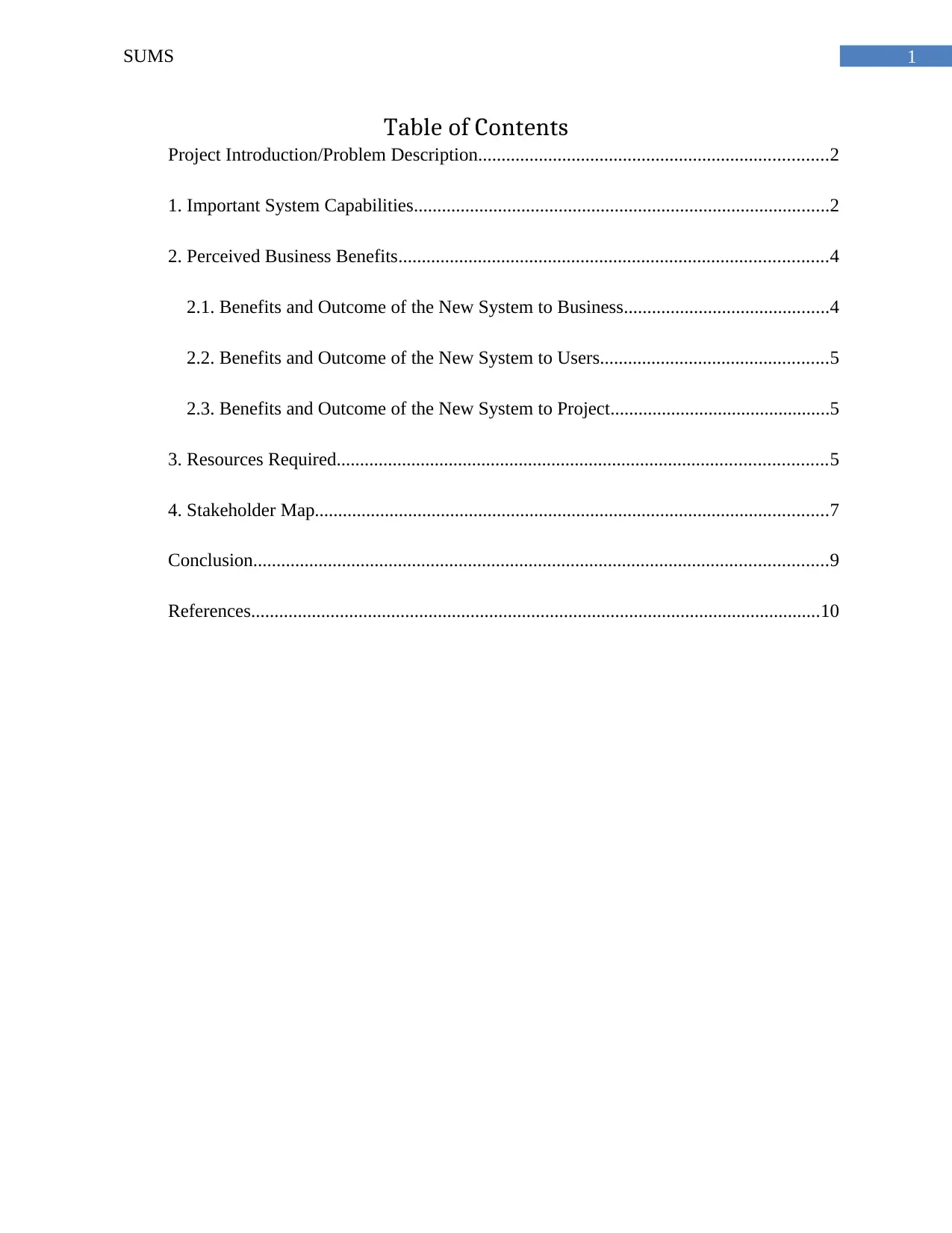
1SUMS
Table of Contents
Project Introduction/Problem Description...........................................................................2
1. Important System Capabilities.........................................................................................2
2. Perceived Business Benefits............................................................................................4
2.1. Benefits and Outcome of the New System to Business............................................4
2.2. Benefits and Outcome of the New System to Users.................................................5
2.3. Benefits and Outcome of the New System to Project...............................................5
3. Resources Required.........................................................................................................5
4. Stakeholder Map..............................................................................................................7
Conclusion...........................................................................................................................9
References..........................................................................................................................10
Table of Contents
Project Introduction/Problem Description...........................................................................2
1. Important System Capabilities.........................................................................................2
2. Perceived Business Benefits............................................................................................4
2.1. Benefits and Outcome of the New System to Business............................................4
2.2. Benefits and Outcome of the New System to Users.................................................5
2.3. Benefits and Outcome of the New System to Project...............................................5
3. Resources Required.........................................................................................................5
4. Stakeholder Map..............................................................................................................7
Conclusion...........................................................................................................................9
References..........................................................................................................................10
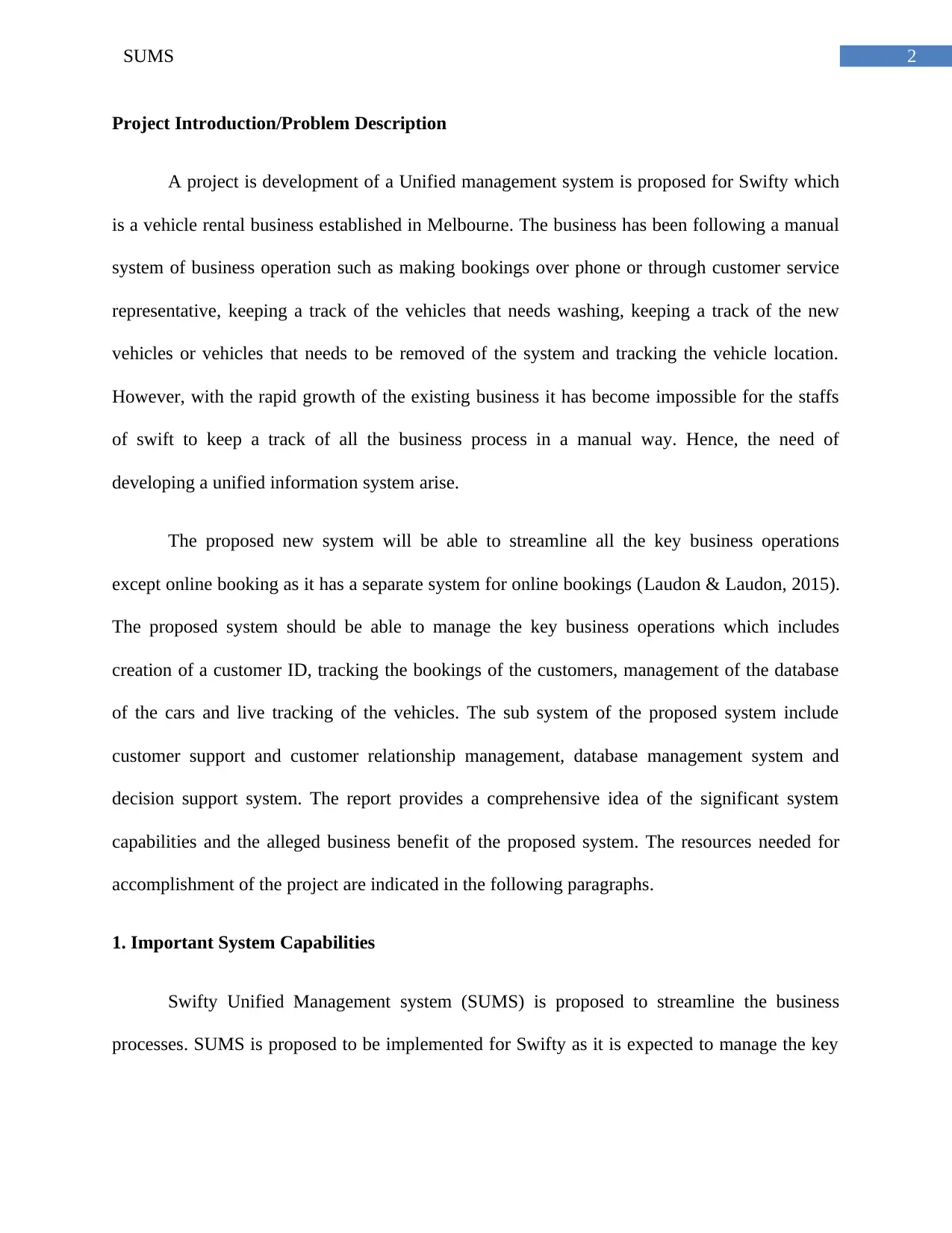
2SUMS
Project Introduction/Problem Description
A project is development of a Unified management system is proposed for Swifty which
is a vehicle rental business established in Melbourne. The business has been following a manual
system of business operation such as making bookings over phone or through customer service
representative, keeping a track of the vehicles that needs washing, keeping a track of the new
vehicles or vehicles that needs to be removed of the system and tracking the vehicle location.
However, with the rapid growth of the existing business it has become impossible for the staffs
of swift to keep a track of all the business process in a manual way. Hence, the need of
developing a unified information system arise.
The proposed new system will be able to streamline all the key business operations
except online booking as it has a separate system for online bookings (Laudon & Laudon, 2015).
The proposed system should be able to manage the key business operations which includes
creation of a customer ID, tracking the bookings of the customers, management of the database
of the cars and live tracking of the vehicles. The sub system of the proposed system include
customer support and customer relationship management, database management system and
decision support system. The report provides a comprehensive idea of the significant system
capabilities and the alleged business benefit of the proposed system. The resources needed for
accomplishment of the project are indicated in the following paragraphs.
1. Important System Capabilities
Swifty Unified Management system (SUMS) is proposed to streamline the business
processes. SUMS is proposed to be implemented for Swifty as it is expected to manage the key
Project Introduction/Problem Description
A project is development of a Unified management system is proposed for Swifty which
is a vehicle rental business established in Melbourne. The business has been following a manual
system of business operation such as making bookings over phone or through customer service
representative, keeping a track of the vehicles that needs washing, keeping a track of the new
vehicles or vehicles that needs to be removed of the system and tracking the vehicle location.
However, with the rapid growth of the existing business it has become impossible for the staffs
of swift to keep a track of all the business process in a manual way. Hence, the need of
developing a unified information system arise.
The proposed new system will be able to streamline all the key business operations
except online booking as it has a separate system for online bookings (Laudon & Laudon, 2015).
The proposed system should be able to manage the key business operations which includes
creation of a customer ID, tracking the bookings of the customers, management of the database
of the cars and live tracking of the vehicles. The sub system of the proposed system include
customer support and customer relationship management, database management system and
decision support system. The report provides a comprehensive idea of the significant system
capabilities and the alleged business benefit of the proposed system. The resources needed for
accomplishment of the project are indicated in the following paragraphs.
1. Important System Capabilities
Swifty Unified Management system (SUMS) is proposed to streamline the business
processes. SUMS is proposed to be implemented for Swifty as it is expected to manage the key
⊘ This is a preview!⊘
Do you want full access?
Subscribe today to unlock all pages.

Trusted by 1+ million students worldwide
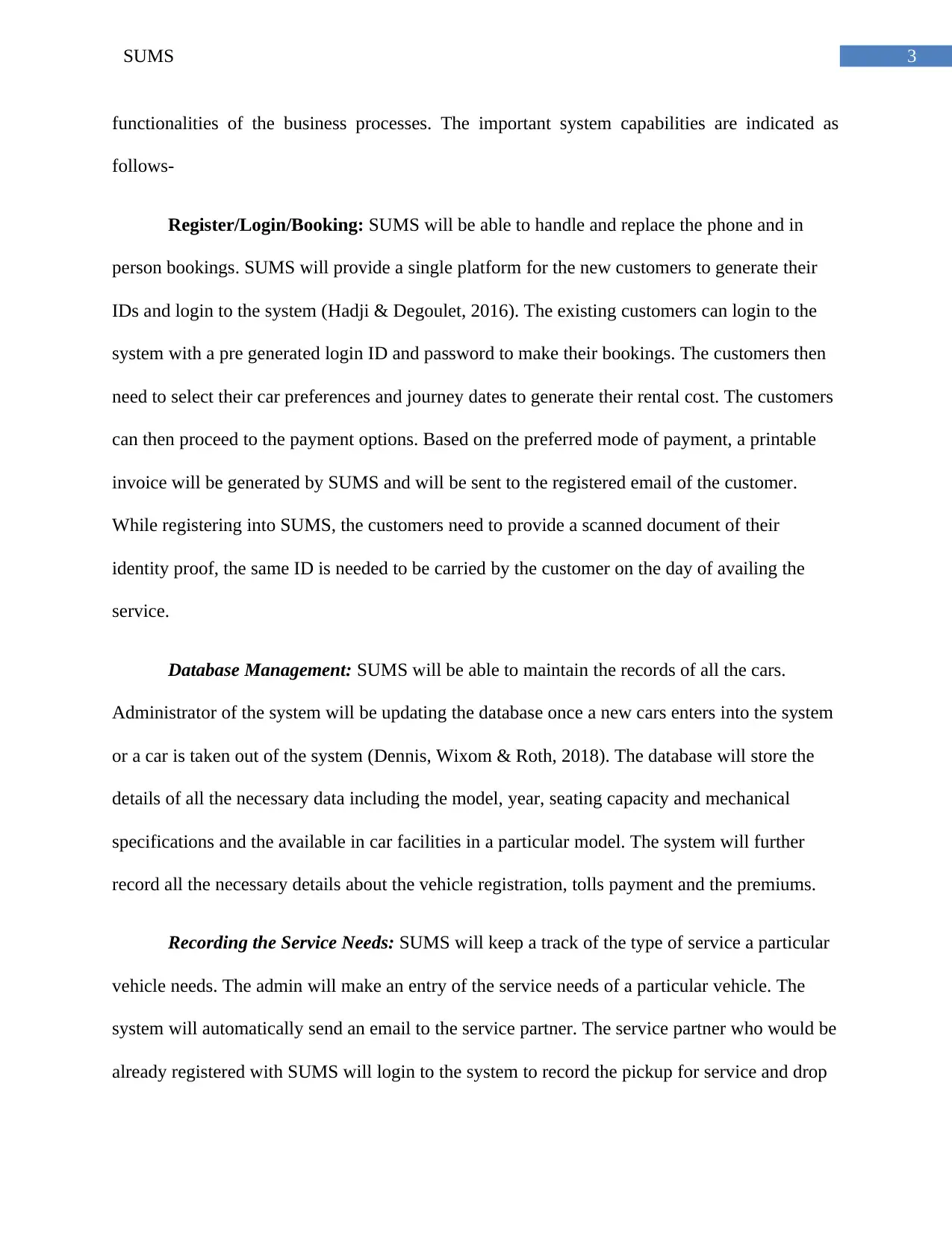
3SUMS
functionalities of the business processes. The important system capabilities are indicated as
follows-
Register/Login/Booking: SUMS will be able to handle and replace the phone and in
person bookings. SUMS will provide a single platform for the new customers to generate their
IDs and login to the system (Hadji & Degoulet, 2016). The existing customers can login to the
system with a pre generated login ID and password to make their bookings. The customers then
need to select their car preferences and journey dates to generate their rental cost. The customers
can then proceed to the payment options. Based on the preferred mode of payment, a printable
invoice will be generated by SUMS and will be sent to the registered email of the customer.
While registering into SUMS, the customers need to provide a scanned document of their
identity proof, the same ID is needed to be carried by the customer on the day of availing the
service.
Database Management: SUMS will be able to maintain the records of all the cars.
Administrator of the system will be updating the database once a new cars enters into the system
or a car is taken out of the system (Dennis, Wixom & Roth, 2018). The database will store the
details of all the necessary data including the model, year, seating capacity and mechanical
specifications and the available in car facilities in a particular model. The system will further
record all the necessary details about the vehicle registration, tolls payment and the premiums.
Recording the Service Needs: SUMS will keep a track of the type of service a particular
vehicle needs. The admin will make an entry of the service needs of a particular vehicle. The
system will automatically send an email to the service partner. The service partner who would be
already registered with SUMS will login to the system to record the pickup for service and drop
functionalities of the business processes. The important system capabilities are indicated as
follows-
Register/Login/Booking: SUMS will be able to handle and replace the phone and in
person bookings. SUMS will provide a single platform for the new customers to generate their
IDs and login to the system (Hadji & Degoulet, 2016). The existing customers can login to the
system with a pre generated login ID and password to make their bookings. The customers then
need to select their car preferences and journey dates to generate their rental cost. The customers
can then proceed to the payment options. Based on the preferred mode of payment, a printable
invoice will be generated by SUMS and will be sent to the registered email of the customer.
While registering into SUMS, the customers need to provide a scanned document of their
identity proof, the same ID is needed to be carried by the customer on the day of availing the
service.
Database Management: SUMS will be able to maintain the records of all the cars.
Administrator of the system will be updating the database once a new cars enters into the system
or a car is taken out of the system (Dennis, Wixom & Roth, 2018). The database will store the
details of all the necessary data including the model, year, seating capacity and mechanical
specifications and the available in car facilities in a particular model. The system will further
record all the necessary details about the vehicle registration, tolls payment and the premiums.
Recording the Service Needs: SUMS will keep a track of the type of service a particular
vehicle needs. The admin will make an entry of the service needs of a particular vehicle. The
system will automatically send an email to the service partner. The service partner who would be
already registered with SUMS will login to the system to record the pickup for service and drop
Paraphrase This Document
Need a fresh take? Get an instant paraphrase of this document with our AI Paraphraser
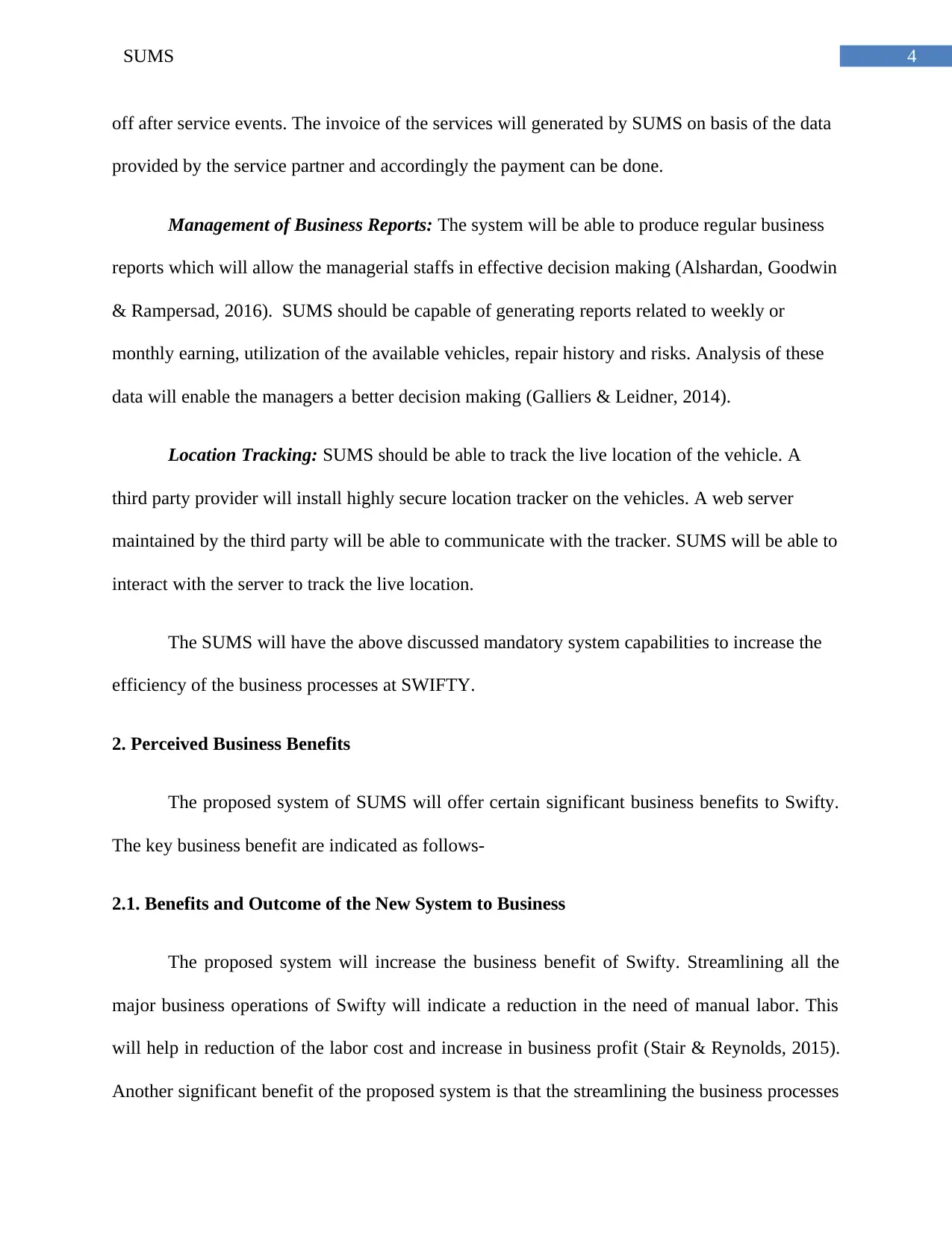
4SUMS
off after service events. The invoice of the services will generated by SUMS on basis of the data
provided by the service partner and accordingly the payment can be done.
Management of Business Reports: The system will be able to produce regular business
reports which will allow the managerial staffs in effective decision making (Alshardan, Goodwin
& Rampersad, 2016). SUMS should be capable of generating reports related to weekly or
monthly earning, utilization of the available vehicles, repair history and risks. Analysis of these
data will enable the managers a better decision making (Galliers & Leidner, 2014).
Location Tracking: SUMS should be able to track the live location of the vehicle. A
third party provider will install highly secure location tracker on the vehicles. A web server
maintained by the third party will be able to communicate with the tracker. SUMS will be able to
interact with the server to track the live location.
The SUMS will have the above discussed mandatory system capabilities to increase the
efficiency of the business processes at SWIFTY.
2. Perceived Business Benefits
The proposed system of SUMS will offer certain significant business benefits to Swifty.
The key business benefit are indicated as follows-
2.1. Benefits and Outcome of the New System to Business
The proposed system will increase the business benefit of Swifty. Streamlining all the
major business operations of Swifty will indicate a reduction in the need of manual labor. This
will help in reduction of the labor cost and increase in business profit (Stair & Reynolds, 2015).
Another significant benefit of the proposed system is that the streamlining the business processes
off after service events. The invoice of the services will generated by SUMS on basis of the data
provided by the service partner and accordingly the payment can be done.
Management of Business Reports: The system will be able to produce regular business
reports which will allow the managerial staffs in effective decision making (Alshardan, Goodwin
& Rampersad, 2016). SUMS should be capable of generating reports related to weekly or
monthly earning, utilization of the available vehicles, repair history and risks. Analysis of these
data will enable the managers a better decision making (Galliers & Leidner, 2014).
Location Tracking: SUMS should be able to track the live location of the vehicle. A
third party provider will install highly secure location tracker on the vehicles. A web server
maintained by the third party will be able to communicate with the tracker. SUMS will be able to
interact with the server to track the live location.
The SUMS will have the above discussed mandatory system capabilities to increase the
efficiency of the business processes at SWIFTY.
2. Perceived Business Benefits
The proposed system of SUMS will offer certain significant business benefits to Swifty.
The key business benefit are indicated as follows-
2.1. Benefits and Outcome of the New System to Business
The proposed system will increase the business benefit of Swifty. Streamlining all the
major business operations of Swifty will indicate a reduction in the need of manual labor. This
will help in reduction of the labor cost and increase in business profit (Stair & Reynolds, 2015).
Another significant benefit of the proposed system is that the streamlining the business processes
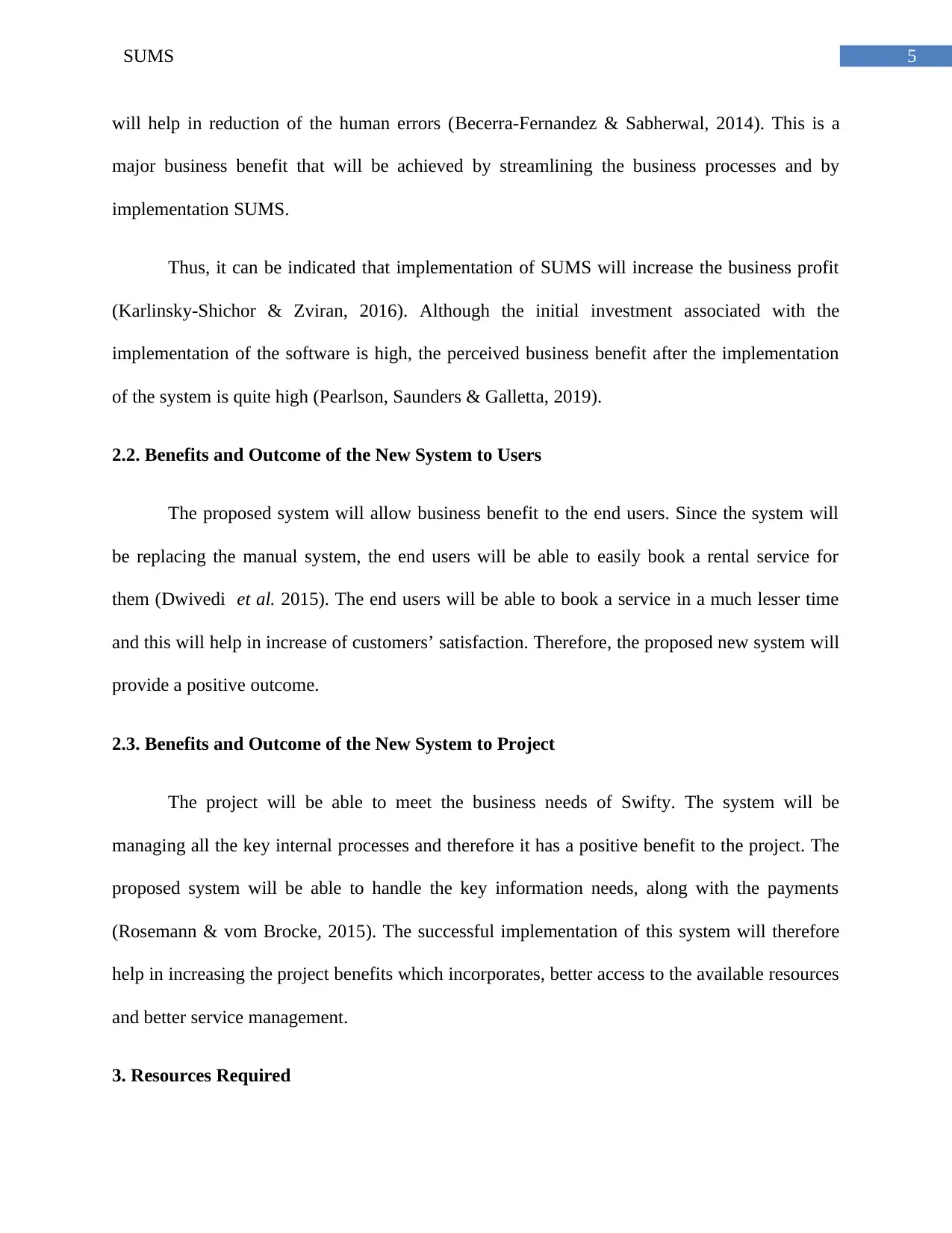
5SUMS
will help in reduction of the human errors (Becerra-Fernandez & Sabherwal, 2014). This is a
major business benefit that will be achieved by streamlining the business processes and by
implementation SUMS.
Thus, it can be indicated that implementation of SUMS will increase the business profit
(Karlinsky-Shichor & Zviran, 2016). Although the initial investment associated with the
implementation of the software is high, the perceived business benefit after the implementation
of the system is quite high (Pearlson, Saunders & Galletta, 2019).
2.2. Benefits and Outcome of the New System to Users
The proposed system will allow business benefit to the end users. Since the system will
be replacing the manual system, the end users will be able to easily book a rental service for
them (Dwivedi et al. 2015). The end users will be able to book a service in a much lesser time
and this will help in increase of customers’ satisfaction. Therefore, the proposed new system will
provide a positive outcome.
2.3. Benefits and Outcome of the New System to Project
The project will be able to meet the business needs of Swifty. The system will be
managing all the key internal processes and therefore it has a positive benefit to the project. The
proposed system will be able to handle the key information needs, along with the payments
(Rosemann & vom Brocke, 2015). The successful implementation of this system will therefore
help in increasing the project benefits which incorporates, better access to the available resources
and better service management.
3. Resources Required
will help in reduction of the human errors (Becerra-Fernandez & Sabherwal, 2014). This is a
major business benefit that will be achieved by streamlining the business processes and by
implementation SUMS.
Thus, it can be indicated that implementation of SUMS will increase the business profit
(Karlinsky-Shichor & Zviran, 2016). Although the initial investment associated with the
implementation of the software is high, the perceived business benefit after the implementation
of the system is quite high (Pearlson, Saunders & Galletta, 2019).
2.2. Benefits and Outcome of the New System to Users
The proposed system will allow business benefit to the end users. Since the system will
be replacing the manual system, the end users will be able to easily book a rental service for
them (Dwivedi et al. 2015). The end users will be able to book a service in a much lesser time
and this will help in increase of customers’ satisfaction. Therefore, the proposed new system will
provide a positive outcome.
2.3. Benefits and Outcome of the New System to Project
The project will be able to meet the business needs of Swifty. The system will be
managing all the key internal processes and therefore it has a positive benefit to the project. The
proposed system will be able to handle the key information needs, along with the payments
(Rosemann & vom Brocke, 2015). The successful implementation of this system will therefore
help in increasing the project benefits which incorporates, better access to the available resources
and better service management.
3. Resources Required
⊘ This is a preview!⊘
Do you want full access?
Subscribe today to unlock all pages.

Trusted by 1+ million students worldwide
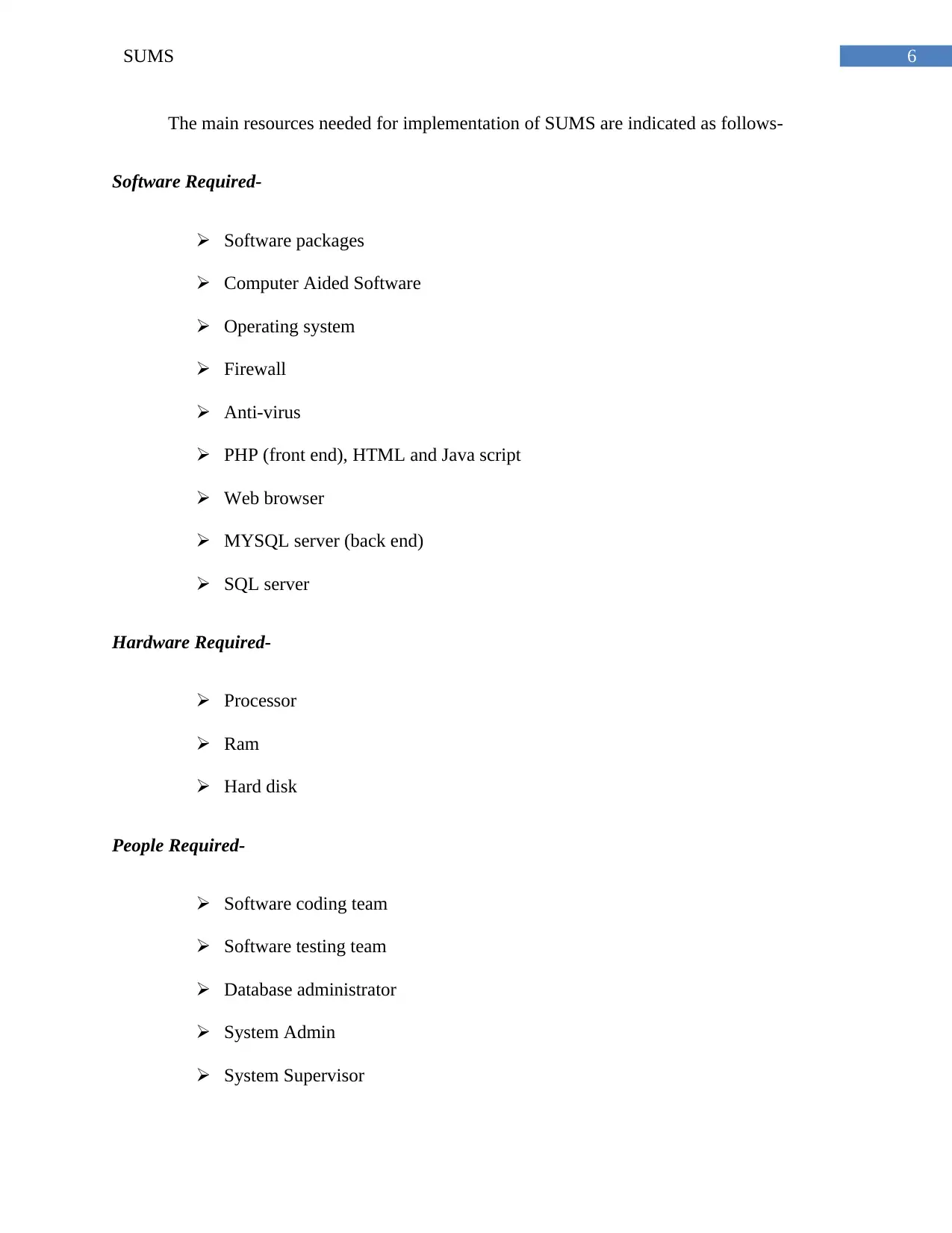
6SUMS
The main resources needed for implementation of SUMS are indicated as follows-
Software Required-
Software packages
Computer Aided Software
Operating system
Firewall
Anti-virus
PHP (front end), HTML and Java script
Web browser
MYSQL server (back end)
SQL server
Hardware Required-
Processor
Ram
Hard disk
People Required-
Software coding team
Software testing team
Database administrator
System Admin
System Supervisor
The main resources needed for implementation of SUMS are indicated as follows-
Software Required-
Software packages
Computer Aided Software
Operating system
Firewall
Anti-virus
PHP (front end), HTML and Java script
Web browser
MYSQL server (back end)
SQL server
Hardware Required-
Processor
Ram
Hard disk
People Required-
Software coding team
Software testing team
Database administrator
System Admin
System Supervisor
Paraphrase This Document
Need a fresh take? Get an instant paraphrase of this document with our AI Paraphraser
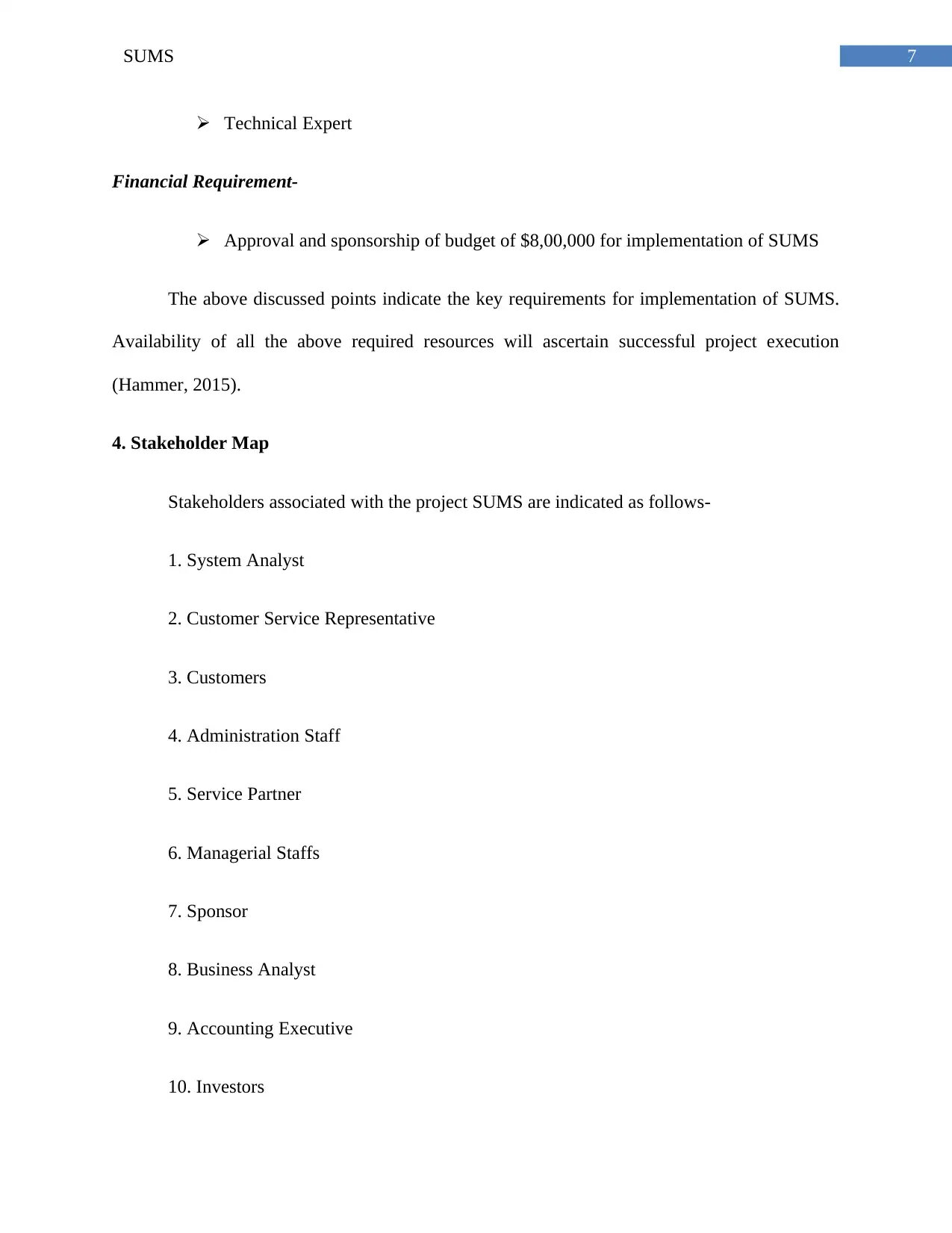
7SUMS
Technical Expert
Financial Requirement-
Approval and sponsorship of budget of $8,00,000 for implementation of SUMS
The above discussed points indicate the key requirements for implementation of SUMS.
Availability of all the above required resources will ascertain successful project execution
(Hammer, 2015).
4. Stakeholder Map
Stakeholders associated with the project SUMS are indicated as follows-
1. System Analyst
2. Customer Service Representative
3. Customers
4. Administration Staff
5. Service Partner
6. Managerial Staffs
7. Sponsor
8. Business Analyst
9. Accounting Executive
10. Investors
Technical Expert
Financial Requirement-
Approval and sponsorship of budget of $8,00,000 for implementation of SUMS
The above discussed points indicate the key requirements for implementation of SUMS.
Availability of all the above required resources will ascertain successful project execution
(Hammer, 2015).
4. Stakeholder Map
Stakeholders associated with the project SUMS are indicated as follows-
1. System Analyst
2. Customer Service Representative
3. Customers
4. Administration Staff
5. Service Partner
6. Managerial Staffs
7. Sponsor
8. Business Analyst
9. Accounting Executive
10. Investors
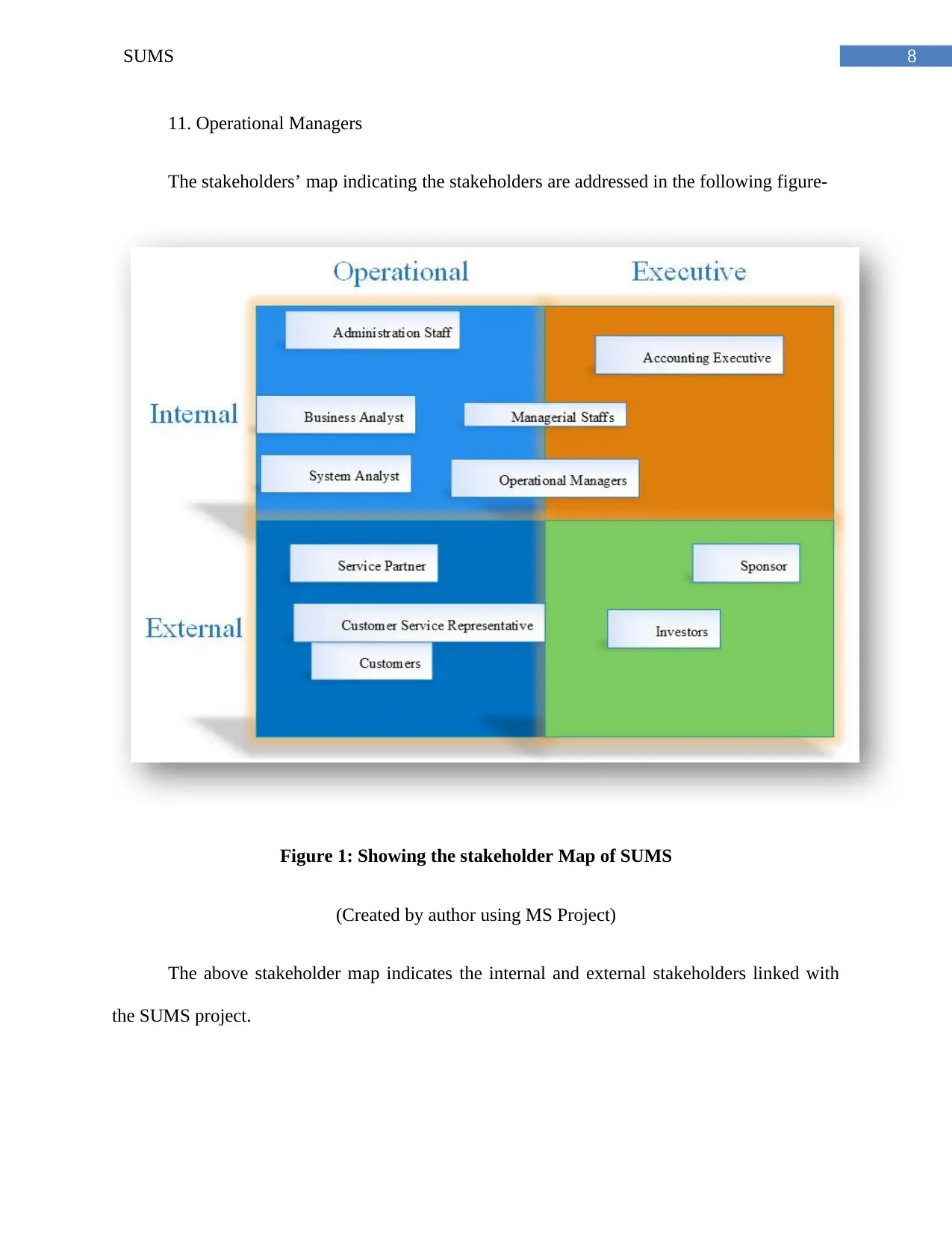
8SUMS
11. Operational Managers
The stakeholders’ map indicating the stakeholders are addressed in the following figure-
Figure 1: Showing the stakeholder Map of SUMS
(Created by author using MS Project)
The above stakeholder map indicates the internal and external stakeholders linked with
the SUMS project.
11. Operational Managers
The stakeholders’ map indicating the stakeholders are addressed in the following figure-
Figure 1: Showing the stakeholder Map of SUMS
(Created by author using MS Project)
The above stakeholder map indicates the internal and external stakeholders linked with
the SUMS project.
⊘ This is a preview!⊘
Do you want full access?
Subscribe today to unlock all pages.

Trusted by 1+ million students worldwide
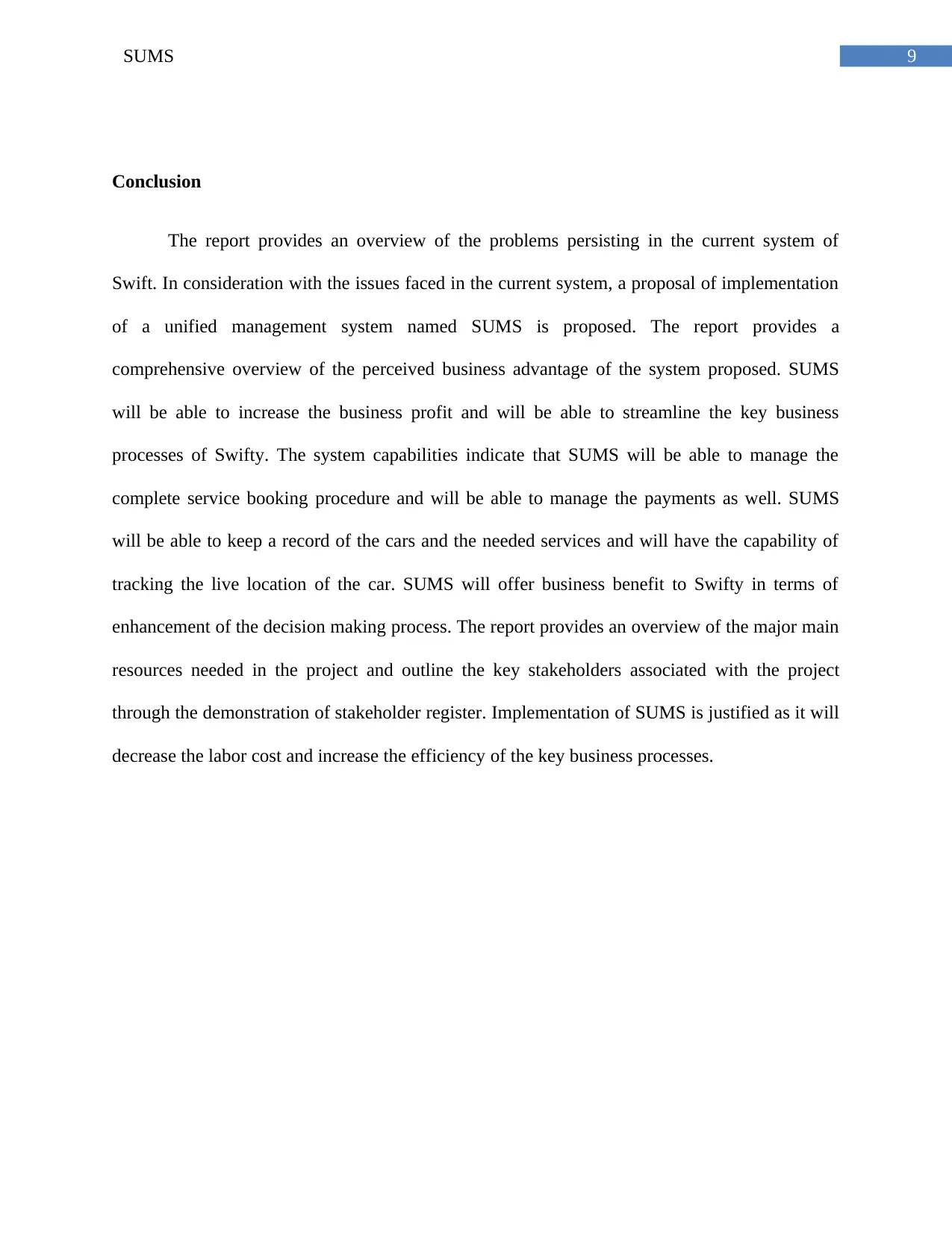
9SUMS
Conclusion
The report provides an overview of the problems persisting in the current system of
Swift. In consideration with the issues faced in the current system, a proposal of implementation
of a unified management system named SUMS is proposed. The report provides a
comprehensive overview of the perceived business advantage of the system proposed. SUMS
will be able to increase the business profit and will be able to streamline the key business
processes of Swifty. The system capabilities indicate that SUMS will be able to manage the
complete service booking procedure and will be able to manage the payments as well. SUMS
will be able to keep a record of the cars and the needed services and will have the capability of
tracking the live location of the car. SUMS will offer business benefit to Swifty in terms of
enhancement of the decision making process. The report provides an overview of the major main
resources needed in the project and outline the key stakeholders associated with the project
through the demonstration of stakeholder register. Implementation of SUMS is justified as it will
decrease the labor cost and increase the efficiency of the key business processes.
Conclusion
The report provides an overview of the problems persisting in the current system of
Swift. In consideration with the issues faced in the current system, a proposal of implementation
of a unified management system named SUMS is proposed. The report provides a
comprehensive overview of the perceived business advantage of the system proposed. SUMS
will be able to increase the business profit and will be able to streamline the key business
processes of Swifty. The system capabilities indicate that SUMS will be able to manage the
complete service booking procedure and will be able to manage the payments as well. SUMS
will be able to keep a record of the cars and the needed services and will have the capability of
tracking the live location of the car. SUMS will offer business benefit to Swifty in terms of
enhancement of the decision making process. The report provides an overview of the major main
resources needed in the project and outline the key stakeholders associated with the project
through the demonstration of stakeholder register. Implementation of SUMS is justified as it will
decrease the labor cost and increase the efficiency of the key business processes.
Paraphrase This Document
Need a fresh take? Get an instant paraphrase of this document with our AI Paraphraser
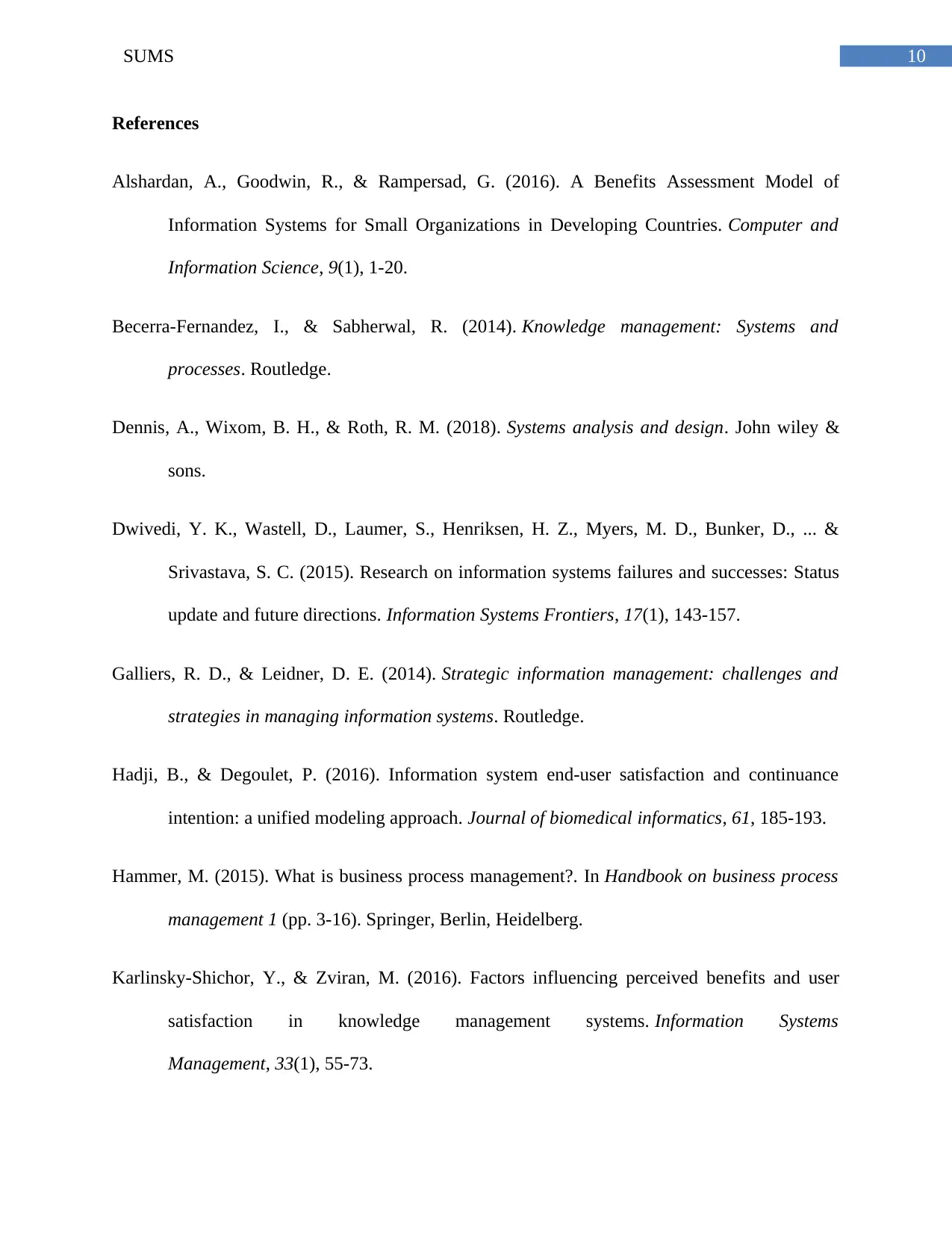
10SUMS
References
Alshardan, A., Goodwin, R., & Rampersad, G. (2016). A Benefits Assessment Model of
Information Systems for Small Organizations in Developing Countries. Computer and
Information Science, 9(1), 1-20.
Becerra-Fernandez, I., & Sabherwal, R. (2014). Knowledge management: Systems and
processes. Routledge.
Dennis, A., Wixom, B. H., & Roth, R. M. (2018). Systems analysis and design. John wiley &
sons.
Dwivedi, Y. K., Wastell, D., Laumer, S., Henriksen, H. Z., Myers, M. D., Bunker, D., ... &
Srivastava, S. C. (2015). Research on information systems failures and successes: Status
update and future directions. Information Systems Frontiers, 17(1), 143-157.
Galliers, R. D., & Leidner, D. E. (2014). Strategic information management: challenges and
strategies in managing information systems. Routledge.
Hadji, B., & Degoulet, P. (2016). Information system end-user satisfaction and continuance
intention: a unified modeling approach. Journal of biomedical informatics, 61, 185-193.
Hammer, M. (2015). What is business process management?. In Handbook on business process
management 1 (pp. 3-16). Springer, Berlin, Heidelberg.
Karlinsky-Shichor, Y., & Zviran, M. (2016). Factors influencing perceived benefits and user
satisfaction in knowledge management systems. Information Systems
Management, 33(1), 55-73.
References
Alshardan, A., Goodwin, R., & Rampersad, G. (2016). A Benefits Assessment Model of
Information Systems for Small Organizations in Developing Countries. Computer and
Information Science, 9(1), 1-20.
Becerra-Fernandez, I., & Sabherwal, R. (2014). Knowledge management: Systems and
processes. Routledge.
Dennis, A., Wixom, B. H., & Roth, R. M. (2018). Systems analysis and design. John wiley &
sons.
Dwivedi, Y. K., Wastell, D., Laumer, S., Henriksen, H. Z., Myers, M. D., Bunker, D., ... &
Srivastava, S. C. (2015). Research on information systems failures and successes: Status
update and future directions. Information Systems Frontiers, 17(1), 143-157.
Galliers, R. D., & Leidner, D. E. (2014). Strategic information management: challenges and
strategies in managing information systems. Routledge.
Hadji, B., & Degoulet, P. (2016). Information system end-user satisfaction and continuance
intention: a unified modeling approach. Journal of biomedical informatics, 61, 185-193.
Hammer, M. (2015). What is business process management?. In Handbook on business process
management 1 (pp. 3-16). Springer, Berlin, Heidelberg.
Karlinsky-Shichor, Y., & Zviran, M. (2016). Factors influencing perceived benefits and user
satisfaction in knowledge management systems. Information Systems
Management, 33(1), 55-73.
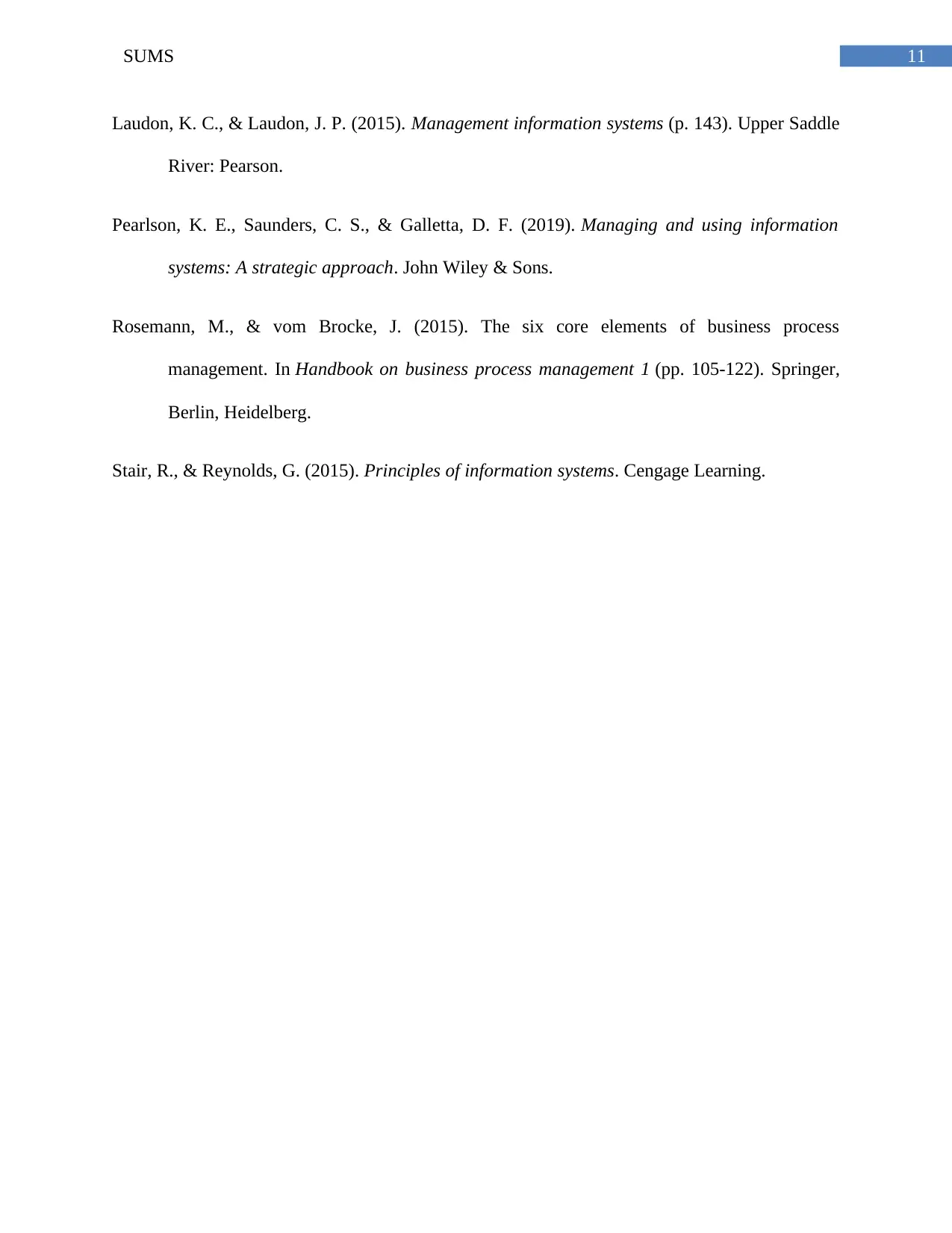
11SUMS
Laudon, K. C., & Laudon, J. P. (2015). Management information systems (p. 143). Upper Saddle
River: Pearson.
Pearlson, K. E., Saunders, C. S., & Galletta, D. F. (2019). Managing and using information
systems: A strategic approach. John Wiley & Sons.
Rosemann, M., & vom Brocke, J. (2015). The six core elements of business process
management. In Handbook on business process management 1 (pp. 105-122). Springer,
Berlin, Heidelberg.
Stair, R., & Reynolds, G. (2015). Principles of information systems. Cengage Learning.
Laudon, K. C., & Laudon, J. P. (2015). Management information systems (p. 143). Upper Saddle
River: Pearson.
Pearlson, K. E., Saunders, C. S., & Galletta, D. F. (2019). Managing and using information
systems: A strategic approach. John Wiley & Sons.
Rosemann, M., & vom Brocke, J. (2015). The six core elements of business process
management. In Handbook on business process management 1 (pp. 105-122). Springer,
Berlin, Heidelberg.
Stair, R., & Reynolds, G. (2015). Principles of information systems. Cengage Learning.
⊘ This is a preview!⊘
Do you want full access?
Subscribe today to unlock all pages.

Trusted by 1+ million students worldwide
1 out of 12
Related Documents
Your All-in-One AI-Powered Toolkit for Academic Success.
+13062052269
info@desklib.com
Available 24*7 on WhatsApp / Email
![[object Object]](/_next/static/media/star-bottom.7253800d.svg)
Unlock your academic potential
Copyright © 2020–2025 A2Z Services. All Rights Reserved. Developed and managed by ZUCOL.





